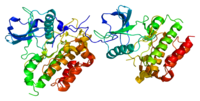
Photo from wikipedia
The TAM (Tyro3, Axl, MerTK) subfamily of receptor tyrosine kinases (RTKs) and their ligands, Gas6 and protein S (ProS1), are implicated in tumorigenesis and chemoresistance in various cancers. The β-galactoside… Click to show full abstract
The TAM (Tyro3, Axl, MerTK) subfamily of receptor tyrosine kinases (RTKs) and their ligands, Gas6 and protein S (ProS1), are implicated in tumorigenesis and chemoresistance in various cancers. The β-galactoside binding protein galectin-3 (Gal-3), which is also implicated in oncogenesis, has previously been shown to be a ligand for MerTK. However, the selectivity of Gal-3 for the other TAM receptors, and its TAM-mediated signalling and functional properties in cancer cells, remain to be explored. The present study was aimed at determining these, including through direct comparison of Gal-3 with the two canonical TAM ligands. Exogenous Gal-3 rapidly stimulated Tyro3 receptor phosphorylation to the same extent as the Tyro3 ligand ProS1, but not Axl, in the cultured human cancer cell lines SCC-25 (express both Tyro3 and Axl) and MGH-U3 (express Tyro3 only). Gal-3 also activated intracellular Erk and Akt kinases in both cell lines and furthermore protected cells from acute apoptosis induced by staurosporine but not from serum-starvation induced apoptosis. In addition, Gal-3 significantly stimulated cancer cell migration rate in the presence of the Axl blocker BGB324. Therefore, these results have shown Gal-3 to be a novel agonist for Tyro3 RTK, activating a Tyro3-Erk signalling axis, as well as Akt signalling, in cancer cells that promotes cell survival, cell cycle progression and cell migration. These data therefore reveal a novel mechanism of Tyro3 RTK activation through the action of Gal-3 that contrasts with those of the known TAM ligands Gas6 and ProS1.
Journal Title: Biomolecules
Year Published: 2020
Link to full text (if available)
Share on Social Media: Sign Up to like & get
recommendations!